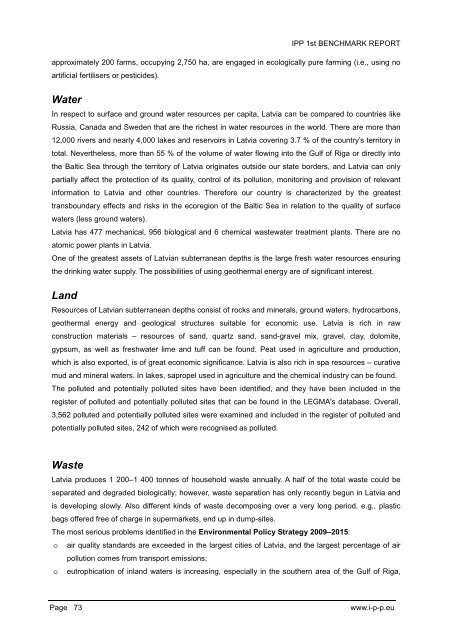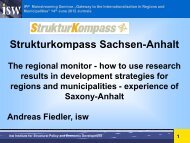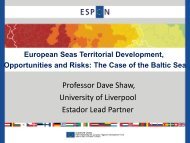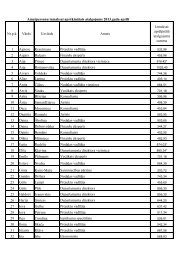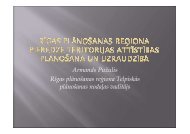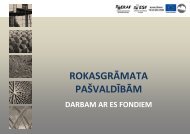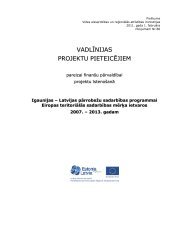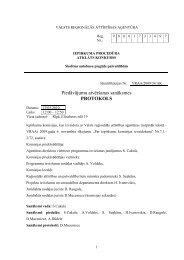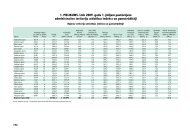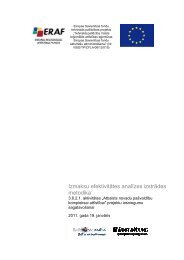Benchmark Study 1
Benchmark Study 1
Benchmark Study 1
Create successful ePaper yourself
Turn your PDF publications into a flip-book with our unique Google optimized e-Paper software.
IPP 1st BENCHMARK REPORT<br />
approximately 200 farms, occupying 2,750 ha, are engaged in ecologically pure farming (i.e., using no<br />
artificial fertilisers or pesticides).<br />
Water<br />
In respect to surface and ground water resources per capita, Latvia can be compared to countries like<br />
Russia, Canada and Sweden that are the richest in water resources in the world. There are more than<br />
12,000 rivers and nearly 4,000 lakes and reservoirs in Latvia covering 3.7 % of the country’s territory in<br />
total. Nevertheless, more than 55 % of the volume of water flowing into the Gulf of Riga or directly into<br />
the Baltic Sea through the territory of Latvia originates outside our state borders, and Latvia can only<br />
partially affect the protection of its quality, control of its pollution, monitoring and provision of relevant<br />
information to Latvia and other countries. Therefore our country is characterized by the greatest<br />
transboundary effects and risks in the ecoregion of the Baltic Sea in relation to the quality of surface<br />
waters (less ground waters).<br />
Latvia has 477 mechanical, 956 biological and 6 chemical wastewater treatment plants. There are no<br />
atomic power plants in Latvia.<br />
One of the greatest assets of Latvian subterranean depths is the large fresh water resources ensuring<br />
the drinking water supply. The possibilities of using geothermal energy are of significant interest.<br />
Land<br />
Resources of Latvian subterranean depths consist of rocks and minerals, ground waters, hydrocarbons,<br />
geothermal energy and geological structures suitable for economic use. Latvia is rich in raw<br />
construction materials – resources of sand, quartz sand, sand-gravel mix, gravel, clay, dolomite,<br />
gypsum, as well as freshwater lime and tuff can be found. Peat used in agriculture and production,<br />
which is also exported, is of great economic significance. Latvia is also rich in spa resources – curative<br />
mud and mineral waters. In lakes, sapropel used in agriculture and the chemical industry can be found.<br />
The polluted and potentially polluted sites have been identified, and they have been included in the<br />
register of polluted and potentially polluted sites that can be found in the LEGMA's database. Overall,<br />
3,562 polluted and potentially polluted sites were examined and included in the register of polluted and<br />
potentially polluted sites, 242 of which were recognised as polluted.<br />
Waste<br />
Latvia produces 1 200–1 400 tonnes of household waste annually. A half of the total waste could be<br />
separated and degraded biologically; however, waste separation has only recently begun in Latvia and<br />
is developing slowly. Also different kinds of waste decomposing over a very long period, e.g., plastic<br />
bags offered free of charge in supermarkets, end up in dump-sites.<br />
The most serious problems identified in the Environmental Policy Strategy 2009–2015:<br />
o air quality standards are exceeded in the largest cities of Latvia, and the largest percentage of air<br />
pollution comes from transport emissions;<br />
o eutrophication of inland waters is increasing, especially in the southern area of the Gulf of Riga,<br />
Page 73<br />
www.i-p-p.eu


